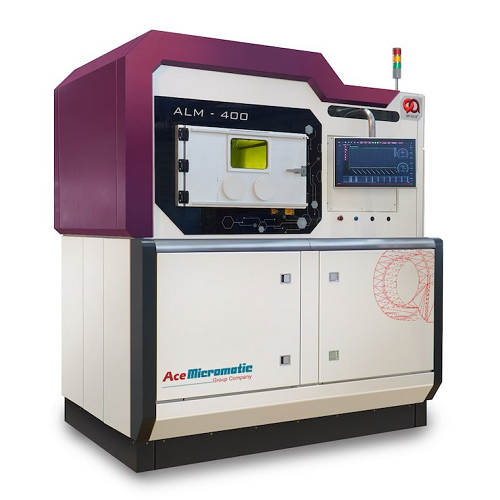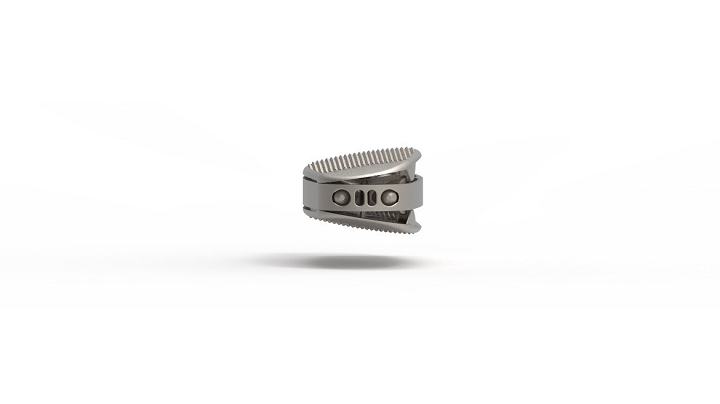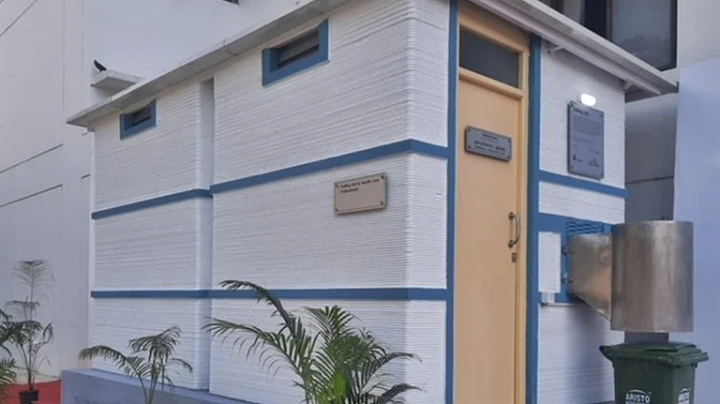In today’s 3D Printing News Briefs, we’re discussing a new 3D printer from Ace Micromatic Group, and moving on to medical 3D printing news out of T&R Biofab and Tsunami Medical. The US Bureau of Industry and Security has imposed some restrictions on 3D printed guns. Finally, there’s a story on a 3D printed concrete bridge and a 3D printed sanitation station for healthcare workers. Keep reading for all the details!
Ace Micromatic Group Launches Metal 3D Printer
Ace Micromatic Group (AMG), an Indian machine tooling company, has introduced its new ALM 400 metal powder bed 3D printer through its amace solutions Pvt Ltd business. With a focus on high productivity and serial production, the ALM 400 can process metal materials like Inconel and titanium alloys, maraging and stainless steels, and aluminum alloys, which would make it a good fit for the aviation, automotive, defense, die mold, medical, and space industries. It features a multi-blade recoating system, automatic filtration, in-situ inspection of part dimensions, and remote monitoring, in addition to two 1KW lasers and the ability to print parts with 30-120 micron layer thicknesses. The ALM 400, with a 410 x 410 x 450 mm build volume is said to be convenient to operate, with intuitive feedback and an improved user experience.
“The versatile machine is developed on the strong foundation of our vast experience in machine building and understanding of metal working machines. Backed with industry expertise and having involved in the technology for the past many years, amace, today has a better understanding of customer requirements. The team has understood the complexities in manufacturing faced by customers and has the right solution through the AM process,” said LS Umesh, CEO & Director of Ace Manufacturing Systems.
T&R Biofab Transplants 3D Printed Liver Tissue into Animal

The researchers’ 3D bioprinting and implantation technique. Image courtesy of the Advanced Materials journal.
Korea-based 3D bioprinter manufacturer T&R Biofab announced that for the first time, it has successfully printed liver tissues and transplanted them into an animal test subject, and published their research in a paper titled “Production of Multiple Cell-Laden Microtissue Spheroids with Biomimetic Hepatic Lobule-like Structure.” The team used one of its modified 3DX bioprinters, microfluidics, and a novel extrusion technique to pattern spherical microtissues into structures, which imitate the hepatic lobules that make up about 80% of the human liver. After the tissue is implanted into mice, the micro-organs that grow inside have exhibited structural stability and great viability. This is good news for future regenerative liver therapies, as UV-based approaches to bioprinting hepatic lobules often need a cross-linker, which can damage the viability of the liver cells, and microscale bioprinted livers transplanted into animals have only kept the subjects alive for up to 25 days.
The abstract reads, “The construction of an in vitro 3D cellular model to mimic the human liver is highly desired for drug discovery and clinical applications, such as patient-specific treatment and cell-based therapy in regenerative medicine. However, current bioprinting strategies are limited in their ability to generate multiple cell-laden microtissues with biomimetic structures. This study presents a method for producing hepatic-lobule-like microtissue spheroids using a bioprinting system incorporating a precursor cartridge and microfluidic emulsification system. The multiple cell-laden microtissue spheroids can be successfully generated at a speed of approximately 45 spheroids min−1 and with a uniform diameter. Hepatic and endothelial cells are patterned in a microtissue spheroid with the biomimetic structure of a liver lobule. The spheroids allow long-term culture with high cell viability, and the structural integrity is maintained longer than that of non-structured spheroids. Furthermore, structured spheroids show high MRP2, albumin, and CD31 expression levels. In addition, the in vivo study reveals that structured microtissue spheroids are stably engrafted. These results demonstrate that the method provides a valuable 3D structured microtissue spheroid model with lobule-like constructs and liver functions.”
Tsunami Medical Still Innovating with GE Additive Technology
Spinal cage and implant provider Tsunami Medical, based in Italy, adopted four Concept Laser AM systems from GE Additive last year, and is continuing to innovate with additive manufacturing today to create high-quality spinal technology. Since the beginning of this year, the company, considered a turn-key specialist in this area, has launched nine 3D printed titanium spinal fusion implants, along with a pedicle screw and rod system, and also recently received regulatory approval from CE Mark to bring next-generation interbody fusion cages and a screw and rod system to market. This second generation of Tsunami Medical’s 3D printed spinal devices, built on years of research and development, add to its line of interbody cages based on successful Bone InGrowth Technology with options for all surgical approaches. Additionally, the devices incorporate plenty of the design and manufacturing advantages that only metal 3D printing can offer in the orthopedic sector, such as pore sizes between 500 and 700 microns for promoting bone ingrowth.
“The deployment of metal additive manufacturing continues at pace in orthopedics. Surgeons and healthcare professionals have become advanced expert users, thanks to their early adoption of the technology. Their comfort level, expertise and desire to innovate result in optimal conditions for accelerating product development and bringing them to market,” explained Stefano Caselli, founder and CEO of Tsunami Medical.
“With four cages featuring built-in additional fixation features, four expandable ones and the first 3D-printed screw-and-rod system in the world, both for open and MIS procedures, we now are offering a full product portfolio for spinal fusion.”
US Department of Commerce Adds Restrictions for 3D Printed Guns
In June, the US Ninth Circuit Court of Appeals issued a preliminary injunction that took 3D printed guns off the US Munitions List (USML), making them exempt from International Traffic in Arms Regulations (ITAR). So now, the Bureau of Industry and Security (BIS), run by the US Department of Commerce, is transferring jurisdiction over some technologies used to make 3D printed guns, stating that any person helping to manufacture, export, or furnish 3D printed firearms is subject to Export Administration Regulations (EAR) instead. This basically means that the BIS has inherited the authority over regulations for 3D printed firearms, which are now subjected to articles 15 CFR 732.2 and 734.7.
You now need a BIS license to post online ‘‘any file, including any CAD file, that once converted will be in an executable code for the production of a firearm,” and these licenses will be valid for four years; anyone intending to export 3D printed guns will be required to provide specifics of the weapons, including their barrel length, caliber, and finish. Manufacturers can submit a free online classification request to the BIS to determine if their specific technology qualifies as “ready for insertion into a computer numerically-controlled machine tool, additive manufacturing equipment or any other equipment.” Additionally, to help the people who possess the 3D printers and software needed to make guns remain compliant and stay on the right side of related licensing laws, the BIS has put together a detailed guide for anyone whose technologies fall under Section C of regulation 734.7.
3D Printed Concrete Bridge Open in Venice
Recently, the 3D printed concrete Striatus bridge was unveiled to the public in Venice, Italy, parametrically designed by ETH Zurich’s Block Research Group and Zaha Hadid Architects, in collaboration with incremental3D and LafargeHolcim. The digital and circular design of the footbridge, called the “first-of-its-kind” by Holcim, is an excellent showcase for what concrete 3D printing is capable of creating, as it’s held together by compression only, with no reinforcements, and wasted very little material but still features maximum strength. The components of the Striatus bridge were designed to be disassembled and reused, and the recycling process is cost-efficient and easy, because no material sorting is needed. Holcim developed a custom, proprietary 3D printing ink for the project from its Tector 3D Build range of mortar inks, and the blocks for the bridge were printed off-site, before being dry assembled in Giardini Marinaressa, where it will be on display through November of 2021.
“This precise method of 3D concrete printing allows us to combine the principles of traditional vaulted construction with digital concrete fabrication to use material only where it is structurally necessary without producing waste,” explained ETH Zurich professor Philippe Block.
3D Printed Sanitization Stations for COVID-19 Safety
Speaking of 3D printed construction, tech startup Tvasta, founded by alumni of the Indian Institute of Technology (IIT) Madras, is working with Saint-Gobain to develop 3D printed sanitization stations that can help safeguard essential healthcare workers and their families as the Delta variant of COVID-19 spreads fast and furiously and the threat of a third coronavirus wave looms. The removal of Personal Protective Equipment (PPE) is called doffing, and it requires that doctors, nurses, and other healthcare workers sanitize themselves after their shifts, before removing their PPE kits and properly disposing of them, so they don’t carry the virus home.
These 3D printed stations by Tvasta and Saint-Gobain are actually 3D printed doffing units, and two have already been launched in Chennai, at a government hospital in Kancheepuram and Omandurar Medical College and Hospital. A third unit, which is still under construction, will eventually be placed at Government Medical College and Hospital in Thiruvalluvar. The doffing units are 3D printed offsite, then transported and assembled onsite at the hospital. Not only does it give healthcare workers a safe place to doff their PPE and sanitize afterwards, but it also decreases the amount of construction workers that need to be near a hospital where COVID-19 patients are admitted.
Subscribe to Our Email Newsletter
Stay up-to-date on all the latest news from the 3D printing industry and receive information and offers from third party vendors.
Print Services
Upload your 3D Models and get them printed quickly and efficiently.
You May Also Like
U.S. Navy Lab Uses 3D Printing to Reduce Tooling Lead Time By Over 90%
The F-35 Lightning II Joint Program Office (JPO), responsible for life-cycle management of the key fifth-generation joint strike fighter (JSF) system used by the U.S., its allies, and its partners,...
Etsy Design Rule Change Reduces Selection of 3D Printed Goods
Online marketplace Etsy has implemented a rule change requiring all 3D printed goods on the site to be original designs. The update to the site’s Creativity Standards states, ¨Items produced using...
Honeywell Qualifies 6K Additive’s Nickel 718 for 3D Printed Aerospace & Defense Parts
6K Additive is renowned for manufacturing sustainable additive manufacturing (AM) powder, and offers a wide portfolio of premium metal and alloy powders that include titanium, copper, stainless steel, and nickel,...
MetalWorm Sells WAAM Systems to Research Institutes in Brazil and Malaysia
Turkish WAAM firm MetalWorm has sold a system in Malaysia and another in Brazil. This is an excellent example of a few emerging trends in additive. Firstly, WAAM was experimented...








































